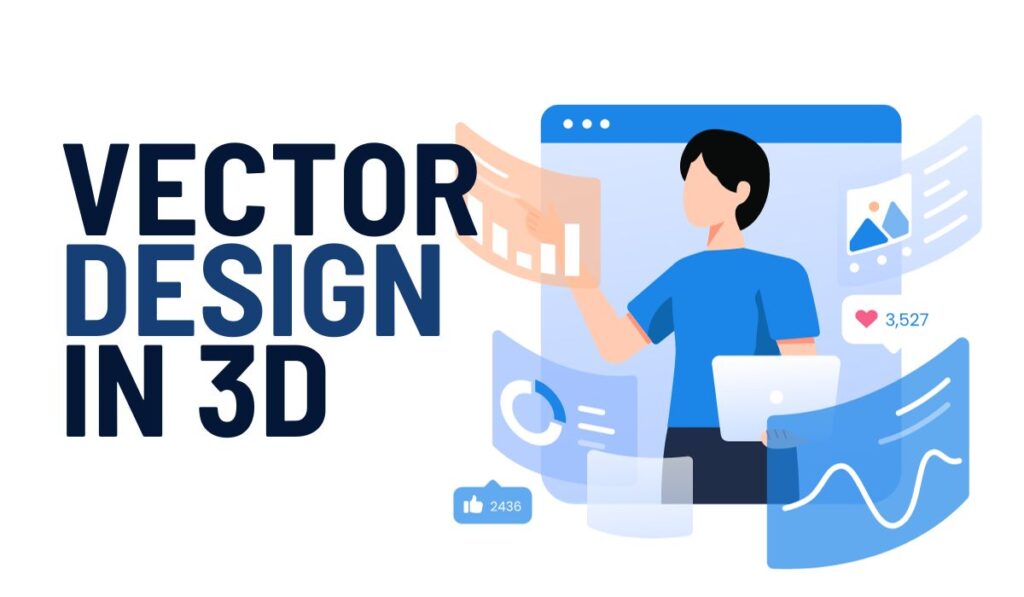Vector Design in 3D: The fusion of 3D aesthetics and vector graphics has created a captivating visual style in digital design. This innovative approach combines the precision of vector art with the depth and perspective of three-dimensional space, creating visually stunning artworks that bridge the gap between the flatness of traditional vector designs and the immersive qualities of 3D environments. In this extensive exploration, we venture into the world of 3D vector design, focusing on isometric and perspective vector art, unveiling the techniques, creative possibilities, and real-world applications of this dynamic fusion.
Understanding the Essence of Isometric and Perspective Vector Art
1. Isometric Vector Art: The Art of Equal Measures
Using a specific axonometric projection, isometric vector art represents three-dimensional objects in a two-dimensional space. Unlike traditional 3D perspectives, where objects appear smaller as they recede into the distance, isometric designs maintain consistent dimensions along all three axes. This uniformity creates a unique visual language where objects are represented equally, allowing for precise and visually engaging compositions.
2. Perspective Vector Art: Adding Depth and Realism
On the other hand, perspective vector art embraces the principles of vanishing points and horizon lines, simulating how human vision perceives depth in the real world. Objects in perspective vector art appear smaller as they move away from the viewer, creating a sense of depth and realism. This technique allows designers to craft immersive scenes, architectural visualizations, and lifelike environments, enhancing the viewer’s sense of presence within the artwork.
Mastering the Techniques of Isometric Vector Art
1. Grids and Guidelines: The Foundation of Isometric Art
Isometric vector art relies heavily on grids and guidelines to maintain consistent proportions and angles. Designers use isometric grids—a series of equidistant parallel lines—to create the illusion of depth. By aligning objects to the grid, artists ensure that elements maintain the correct isometric perspective, resulting in a cohesive and visually pleasing composition.
2. Basic Shapes and Building Blocks
Isometric vector art often starts with basic shapes and building blocks. These simple forms, such as cubes, rectangles, and pyramids, are the foundation for more complex designs. By manipulating and combining these shapes, artists can create intricate structures, landscapes, and objects while preserving the isometric perspective. Mastering the art of transforming basic shapes is essential for crafting detailed and visually appealing isometric vector art.
3. Lighting and Shadows: Adding Depth and Dimension
Lighting and shadows are crucial in conveying depth and dimensionality in isometric vector art. Understanding light sources and their impact on surfaces is essential for creating realistic and visually striking artworks. By strategically placing highlights and shadows, artists can emphasize contours, add depth to objects, and create a sense of volume. Attention to lighting nuances enhances the overall visual impact of isometric vector art, making the artwork more immersive and lifelike.
4. Textures and Details: Elevating Isometric Artwork
Textures and intricate details elevate isometric vector art to a new level of sophistication. Adding textures to surfaces, such as wood grain, stone patterns, or metallic finishes, creates a tactile quality, enhancing the viewer’s visual experience. Fine details, such as intricate carvings, foliage, or surface imperfections, contribute to the overall richness of the artwork. Artists infuse life into their isometric designs by meticulously incorporating textures and details, making them captivating and visually engaging.
Exploring the Depths of Perspective Vector Art
1. The Magic of Vanishing Points and Horizon Lines
Perspective vector art relies on vanishing points and horizon lines to create the illusion of depth and distance. Vanishing points are points on the horizon where parallel lines appear to converge, while the horizon line represents the viewer’s eye level. By aligning elements to these points and lines, artists can achieve realistic perspective, making objects recede into the distance and creating a convincing sense of space.
2. Foreshortening: Distorting for Realism
Foreshortening is a technique used in perspective vector art to create the illusion of objects receding into the distance or projecting toward the viewer. It involves distorting the proportions of objects based on their angle relative to the viewer. By mastering foreshortening, artists can create dynamic compositions, with objects appearing realistically three-dimensional, even on a two-dimensional surface. This technique adds drama and movement to perspective vector art, making it visually compelling.
3. Atmospheric Perspective: Simulating Depth Through Color and Contrast
Atmospheric perspective, also known as aerial perspective, simulates how distant objects appear less distinct and bluer due to atmospheric conditions. In perspective vector art, artists use subtle changes in colour, contrast, and detail to convey depth and distance. Distant objects are rendered with muted colours, lower contrast, and fewer details, creating a natural gradient that mimics the effects of the atmosphere. This technique enhances the realism of the artwork, making distant landscapes and cityscapes appear more authentic and immersive.
4. Overlapping and Layering: Creating Depth Through Composition
Overlapping and layering are fundamental techniques in perspective vector art that create depth by positioning objects in front of or behind one another. Objects that overlap others appear closer to the viewer, while objects positioned behind convey distance. Artists can establish a sense of space and depth by skillfully arranging elements in the composition. Layering adds realism and enhances the visual storytelling within the artwork, guiding the viewer’s focus and creating a sense of depth perception.
Real-World Applications of Isometric and Perspective Vector Art
1. Architectural Visualization and Design
Isometric and perspective vector art find extensive applications in architectural visualization and design. Architects and designers use these techniques to create detailed floor plans, building layouts, and interior designs. Isometric views provide a clear and comprehensive representation of architectural spaces, showcasing exterior and interior elements. On the other hand, perspective views offer a realistic portrayal of buildings, allowing clients and stakeholders to visualize the final construction. Isometric and perspective vector art enhance the communication of architectural concepts, enabling clients to grasp the design intent effectively.
2. Digital Games and Interactive Media
The gaming industry utilizes isometric and perspective vector art to create immersive game environments. Isometric graphics are prevalent in strategy, simulation, and role-playing games, providing players with a bird’s-eye view of the game world. Perspective vector art enhances the visual appeal of 3D games, adding depth and realism to characters, landscapes, and objects. Interactive media, including mobile apps and websites, incorporate isometric and perspective vector art to create visually engaging interfaces and interactive experiences. These art styles contribute to the overall atmosphere and gameplay experience, immersing players and users in captivating digital worlds.
3. Advertising and Marketing
Isometric and perspective vector art plays a vital role in advertising and marketing campaigns. Advertisers use these techniques to create visually appealing product illustrations, architectural visualizations, and infographics. Isometric illustrations showcase products and services from various angles, highlighting their features and benefits. Perspective vector art adds depth and realism to marketing materials, making products and concepts more enticing to consumers. These art styles enhance the visual storytelling in advertisements, conveying messages effectively and leaving a lasting impression on the audience.
4. Educational and Explainer Videos
Educational content and explainer videos leverage isometric and perspective vector art to simplify complex concepts and processes. Isometric diagrams break down intricate structures and systems into digestible visual components, enhancing understanding. Perspective vector art brings historical events, scientific phenomena, and educational narratives to life, making learning engaging and accessible. These art styles simplify abstract ideas, making them visually engaging and relatable to learners of all ages.
Conclusion: The Fusion of Precision and Depth in Vector Design
Isometric and perspective vector art represents a harmonious fusion of precision and depth, transforming flat surfaces into immersive and visually compelling experiences. The meticulous alignment of lines, the strategic use of vanishing points, and the thoughtful application of colour and detail elevate vector art to new dimensions. These techniques have reshaped how we perceive and interact with digital content, from architectural visualisations to interactive games.
As technology advances and design tools become more sophisticated, the boundaries of isometric and perspective vector art continue to expand. Designers and artists, armed with creativity and technical expertise, explore new horizons, pushing the limits of what can be achieved with vector graphics. The marriage of accuracy and depth in these art styles enriches visual storytelling and captivates audiences, leaving them in awe of the intricate worlds and detailed designs that come to life through the magic of isometric and perspective vector art. As we journey into the digital age, these techniques are poised to redefine our visual landscape, one meticulously crafted line at a time.
Frequently Asked Questions (FAQs)
What is the main difference between isometric and perspective vector art?
Isometric vector art represents three-dimensional objects in a two-dimensional space using a specific axonometric projection, maintaining consistent dimensions along all three axes. On the other hand, perspective vector art uses vanishing points and horizon lines to create the illusion of depth and distance, simulating how human vision perceives objects in three-dimensional space. While isometric art maintains equal measurements, perspective art employs foreshortening and atmospheric perspective for a realistic sense of depth.
What are the fundamental techniques for creating isometric vector art?
Creating isometric vector art involves grids and guidelines for consistent proportions and angles. Designers often start with basic shapes and building blocks, manipulating and combining them to create intricate designs. Lighting and shadows play a significant role, emphasizing contours and adding depth. Attention to textures, details, and careful use of colour enhance the overall richness of isometric vector art, creating visually appealing and immersive compositions.
How does perspective vector art achieve a sense of realism?
Perspective vector art achieves realism by incorporating vanishing points, horizon lines, and foreshortening techniques. Objects are strategically arranged in the composition, considering overlapping and layering to create a sense of depth. Atmospheric perspective, which involves adjusting colour, contrast, and detail based on distance, simulates the effects of the atmosphere. These techniques combine to create a convincing illusion of three-dimensional space, making perspective vector art visually compelling and lifelike.
In what industries are isometric and perspective vector art commonly used?
Isometric and perspective vector art find applications in various industries, including architecture and interior design for visualizing structures, digital gaming for creating immersive game environments, advertising and marketing for captivating product illustrations, and educational content for simplifying complex concepts. These art styles are also utilized in interactive media, such as websites and mobile apps, to enhance user interfaces and create engaging user experiences.
What software tools are commonly used for creating isometric and perspective vector art?
Several software tools are popular among designers and artists for creating isometric and perspective vector art. Adobe Illustrator, a versatile vector graphics editor, is widely used for its robust features and precise controls. Other software options include CorelDRAW, Inkscape, and Affinity Designer. These tools provide the necessary tools and functionalities for creating intricate and visually appealing isometric and perspective vector artworks.


